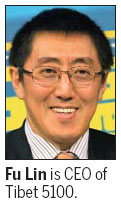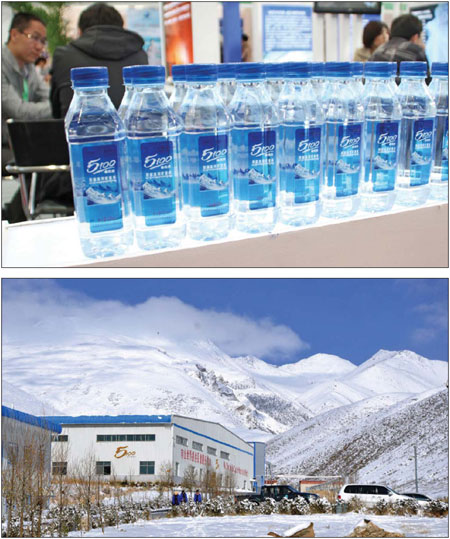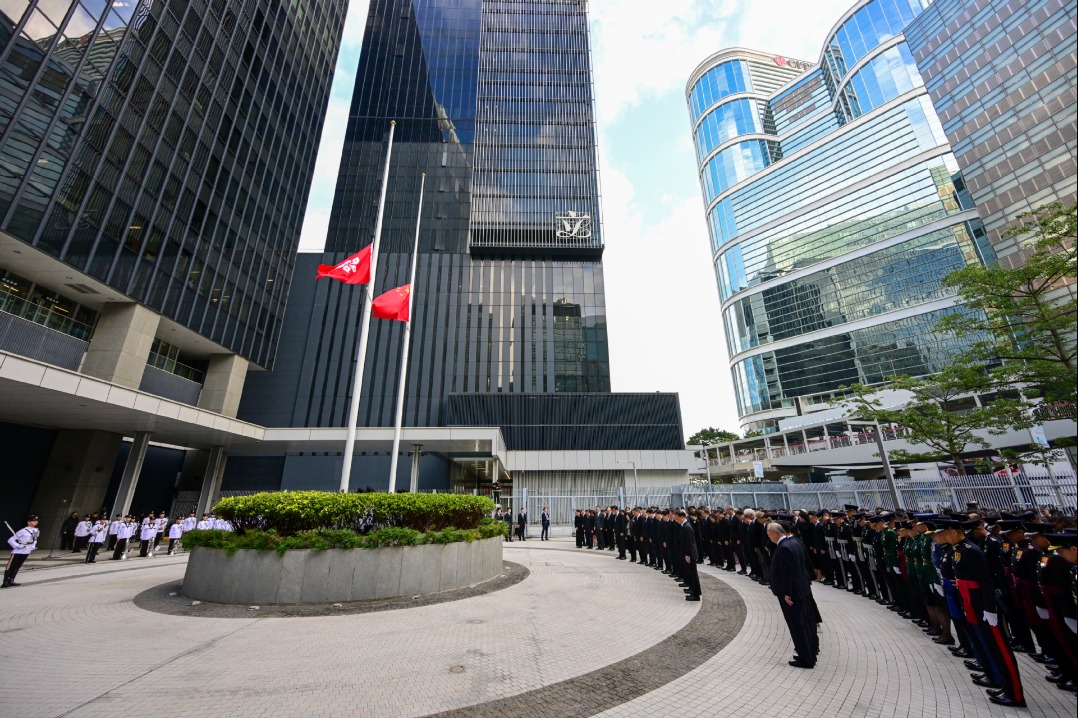Flowing well from roof of the world

|
Top: Tibet 5100's bottled mineral water is on display during a promotion in Beijing in April. Below: The company's workshops in Tibet. The source of the water is the Qu Ma Nong Spring, which is 5,100 meters above sea level. Photos Provided to China Daily |
Bottled water company looks to exploit its natural advantage
When it comes to the Tibet autonomous region, people's first thoughts are of remote landscapes, hauntingly beautiful views and ancient history. Business and commerce rarely come to mind.
But Lhasa-based bottled water company Tibet 5100 hopes to change that business-free picture, through international success.
Fu Lin, the company's CEO, was invited to speak at the Global Bottled Water Congress in Barcelona, Spain, from Oct 8 to 10. It was only the second time a Chinese company has attended the annual event, which attracts big international brands including Coca Cola, Nestle Waters and the Danone Group.
 |
"It is a platform for bottled water producers, suppliers, customers and other industry partners to gain a complete overview of market trends and developments. Being invited to speak at it shows that Tibet 5100 has gained international acceptance," Fu says.
It was an important moment for the company and confirmation that its hard work to create a quality product and image that can stand alongside top international brands has paid off.
China is known as a manufacturing hub, but not for its water products. Overseas brands including Evian and Perrier dominate the market.
"The international bottled water market is more mature than in China. We will keep our own characteristics, but at the same time we have to keep up with industry developments," Fu says.
Fu opened his conference speech with a joke. "Although it is a little hard for me to get used to the lower altitude here as I have come from Tibet, the roof of the world, I can still feel the passion of Spain."
"I shared our business model with the conference and talked about the future of China's water market," he says.
Tibet 5100 is one of a handful of Chinese water brands able to compete with global players.
Established in October 2005, it marked its international debut at the International Food Exhibition in Cologne, Germany in 2007.
"The first time we attended the exhibition, more than 100 overseas distributors expressed an interest in our water," he says.
"But we thought we needed to improve our product, so we decided to wait and prepare more."
Last year, Tibet 5100's authorized distributor signed the strategic export cooperation with Chateau Classic, a subsidiary company of Hawesko Holding AG Group, the largest high-class wine distributor in Europe, to promote and sell Tibet 5100 in Europe.
In June last year, the company listed on the Hong Kong stock exchange, a moment Fu describes as "the happiest" in his life.
Now Fu wants to expand globally and plans to build a glass bottle production line later this year. He says, glass maintains the water's qualities better during transport.
"We have a two-step overseas plan. Firstly, we will access markets near China like the Middle East, Southeast Asia and Singapore. Secondly, we will approach Europe and the US," Fu says.
"We see this as a good chance for Tibet 5100 to expand its business globally and accelerate the company's development."
Tibet 5100 Glacier Spring Water is sourced from the Qu Ma Nong Spring, a glacial spring 5,100 meters above sea level that comes from the Nianqing Donggula Mountains on the Tibetan Plateau.
"This also marks the origin of our brand name," says Fu. "The source of our water is the mountain's quaternary glacier, which has been in existence for millions of years."
With low deuterium content and weak alkaline properties, the water flows naturally and remains stable at around 24 C.
"It is one of the most precious mineral waters in Tibet and the whole of China," Fu says.
Recalling the company's tough beginnings, Fu says: "To guarantee premium water quality, we set up our production plant beside our water source, including four German Krone production lines, three Husky preform injection molding production lines and one Husky cap production line."
Erecting these was hard work due to the high attitude. "Our German experts and some of our other staff fainted several times during the installation process due to high altitude anoxia," Fu says. "They needed oxygen to finish the work."
Tibet 5100 has the highest altitude bottled water production line in the world.
Since Evian became the first company to begin bottling water in China in 1986, the industry has witnessed rapid development.
Wahaha and Nongfu are among the most widely recognized bottled waters in China today.
A 330 ml bottle of Tibet 5100's mineral water costs 7.5 yuan ($1.20; 0.92 euro) retail, about five times the price of a 550 ml bottle from a non-premium company, but still less than the price of Evian.
According to market research firm Euromonitor International, in 2011 Tibet 5100 had captured a 26.9 percent share of China's premium bottled mineral water market, making it a leading brand.
From 2008 to 2011, the company's compound annual growth rate in terms of income was 74 percent, while its net profit CAGR was 215 percent.
"Our strategy focuses on penetrating institutional sales channels, an approach which distinguishes us from the competition," Fu says.
In 2007, Tibet 5100 signed a strategic contract with China Railway Express, a State-owned transportation company affiliated with the Ministry of Railways. The contract gave 5100 Tibet access to the high-speed train market and was decisive in its commercial success.
In 2010, water sold to China Railway Express accounted for 81 percent of Tibet 5100's revenue.
While landing a major client was good for company revenue, experts have said that relying so heavily on one client also poses a risk.
The management of Tibet 5100 know this and have moved to land other institutional clients, whose base and sales have continued to grow, covering Air China, China Railway Express, China Post, BP-Petro, Sinopec, ICBC International and CCB International.In its 2012 semiannual report, Tibet 5100 says its reliance on China Railway was reduced to 27 percent.
The company has also taken other steps to diversify its sales base.
"Based on powerful logistics systems covering 48 cities nationwide, Tibet 5100 has created a water card service unique to China," Fu says.
The water card is a prepaid voucher used to buy the company's bottled water. Customers dial a national hotline and bottled water is delivered to an appointed place within 48 hours.
The company has also expanded its institutional client base by sponsoring government and business activities, such as the HSBC International Golf Championship, the China Tennis Open, the World Economic Forum and the World Expo in Shanghai.
"In April, we also partnered with some Internet malls, including Amazon, to start online sales of the water card, in order to further explore business-to-consumer channels and provide premium clients with a more convenient service," Fu says.
According to its latest financial report, Tibet 5100's revenues in 2011 were 633 million yuan, up 76 percent from the previous year.
Despite the company's rapid growth, it remains a challenge to create brand recognition. But Fu believes the situation will improve.
"Our water comes from a pure and rare glacier spring in Tibet, which is attractive to the global market," he says.
According to Euromonitor, the capacity of China's premium bottled mineral water market will continue to grow between 2012 and 2016, with a CAGR of 14 percent.
"We hope Tibet 5100 can be part of the international premium mineral water market and establish itself as a world-famous brand," Fu says.
zhangchunyan@chinadaily.com.cn
(China Daily 10/19/2012 page21)
Today's Top News
- Xi stresses improving long-term mechanisms for cyberspace governance
- Experts share ideas on advancing human rights
- Japan PM's remarks on Taiwan send severely wrong signal
- Key steps to boost RMB's intl standing highlighted
- Sustained fight against corruption urged
- Xi calls for promotion of spirit of volunteerism































